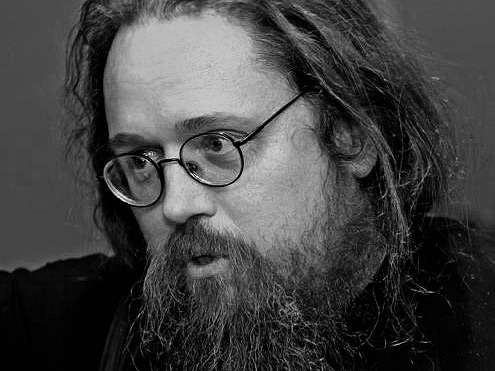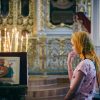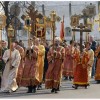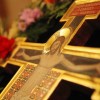 2000 years of Christianity are going to be noted everywhere. The most discussed question, both within the Church and outside it, is what 2000 years of Christianity mean and how to relate to them.
2000 years of Christianity are going to be noted everywhere. The most discussed question, both within the Church and outside it, is what 2000 years of Christianity mean and how to relate to them.
Different people view this milestone in very different ways. For a Christian, it is a joyful date, confirming the most important dogma of our faith: “God is Love.” For love is long-suffering. And by no means can we say that the past two millennia have been millennia filled only with holiness. For the most part, these have been 2000 years of our sins and transgressions. The Lord has tolerated us for these 2000 years and has not renounced us. Instead, He has continued pouring His mercies on His people, the Church (through revealing new sacred objects, and miracles, but mostly through simply sustaining our lives and the existence of our Church). That means that our God is truly a long-suffering God, which means that God truly is Love. That Christianity is not dying but is crossing over into a new millennium is a joy for us. For Christians, another “millennium” symbolizes Christianity’s eternity, and we are entering the third millennium of our history certain that the Church’s mission is going continue beyond 2000.
However, there are people who are going to celebrate the new millennium with joy based on a completely different motivation. An increasing number of secular publications, gossip stories, and even jokes hint: “You, Christians, are two thousand years old.” ” That is a considerable age,” they say. “Therefore, dear ladies and gentlemen Orthodox Christians, would you mind getting out of culture, politics, economics, and schools? Your place is in the depths of history, in the museum. We will cross the millennium’s border, but without your moss-covered Christianity.” “It is time,” they say, “for Christianity’s well-deserved retirement and for preaching ‘The Third Testament,’ the New Age religion instead.”
There is one generally accepted phrase that prompts me to exclaim “Contradicitur!” (“I object!”) every time I hear it. That phrase is the “cultural legacy of Orthodoxy.” When I hear that expression, I feel obliged to interrupt and say, “Excuse me, what legacy are you talking about? A legacy appears where the legator has died. Yet we are quite alive. And I am sorry to say this, but we have bequeathed nothing to you, unbelievers! Only in the Soviet period did it seem that Orthodoxy was no more and there were only objects of ‘cultural legacy’ left: frescoes (what you would call ‘monumental painting’), icons (‘works of tempera art’), and churches (‘medieval architecture monuments’)—and all that ‘legacy’ could be used at will. Yet we feel that it is we who constitute the Church, that very Church of St. Andrei Rublev[1] and St. Sergius of Radonezh[2], and that we have not willed anything to the secular people. Everything that you call ‘the cultural legacy of medieval Orthodoxy’ is ours, and we live in our own home rather than in a cemetery or the Orthodox Church Museum.”
Christianity has not disappeared and one can be a Christian even in the XXI century.
But what does it mean to be a Christian? I will try to give several answers to that question, and each consecutive answer will include the preceding one.
The first answer is so evident and simple that I feel rather hesitant to offer it to my educated audience, which is accustomed to sophisticated intellectual games. But truth does not have to be sophisticated, “dialectical,[3]”“antinomic,[4]” or even “dialogically carnival.” A Christian is simply a person who looks at Christ through the Apostles’ eyes. That is it. Further we might say that a Christian is spiritual or non-spiritual, profound or superficial, but the necessary, minimum requirement for being a Christian is exactly this: to look at Christ through the Apostles’ eyes.
The thing is that one may look at Christ in different ways. One may look at him with the eyes of the Holy Apostle John while another may look at him with Judas’ eyes… The late 1950s, a time that the newspapers call “Khrushchev’s Thaw,[5]”witnessed a wave of memoirs written by classical authors of Soviet culture. Initial information surfaced about people who had perished in concentration camps, were arrested or persecuted—outstanding scientists, poets, and writers among them. And then those who had been thriving and receiving Stalin’s awards and orders rushed to protect their success, which began to look rather scandalous against the tragic backdrop of their colleagues who had been subjected to repression. “Of course I was friends with those who were in the Gulag and I even tried to protect them. So what if I had to write an article for the “Pravda[6]” newspaper against that friend? At the same time, I tried to protect him to the best of my ability. They demanded that I write that he was a Japanese intelligence agent; I, however, limited myself to writing that he was deeply mistaken. I myself barely escaped being arrested! I was protecting him so courageously that I received only the second-class award, even though I deserved the first-class one for my talents!” It was then that a biting epigram appeared in the uncensored, so-called samizdat[7], literature:
Apparently, publishers’ consciences are clean
And monsters among them can also be found:
For Christ’s new biography has just appeared
That’s based on Judas’ best-selling account.
Again, one may look at Christ with different eyes. There is Judas’ view of Christ or Pontius Pilate’s view of Him (Pilate’s view of Christ is represented in Mikhail Bulgakov’s novel The Master and Margarita[8]). Pilate’s view is not a hating glare, but a cold, indifferent stare… There is one question in the Gospel that Christ did not answer, despite His omniscience. Far from being peripheral, it was the most important question: “What is truth?”
Why did the Savior choose not to answer that question? It was not because He did not know what Truth was. He Himself was the Truth (“I am the way, the truth, and the life. . .” (Jn 14:6). But a great deal depends on the intonation of the question being asked.
The conversation between Pontius Pilate and Christ is like a confrontation between all of pagan wisdom and the New Gospel. The wise pagan empire had grown so decrepit that its best scientists proclaimed, as the result of their searching, that man can perceive nothing. That is the final conclusion of philosophy of those days, the philosophy of skepticism and relativism. Nothing can be known for certain. Man is incapable of learning anything true about the world or himself; the philosophers had already proven the feebleness of the human mind and the relativity of all our ideas.
And here we have Pontius Pilate, an educated man who is familiar with the ancient satirical literature that sneers at popular mythology (“Having said so much of these [divine] matters, we pray that we may have grace from both the gods and the heroes for our speech” (Herodotus.The Histories. 2:45).) Pilate himself does not believe in myths very much. He is a politician and lives a worldly life. When he meets Jesus, he clarifies for himself the most important thing: Jesus the Galilean is not a rebel, He does not threaten the empire in any way, and so there is not much to talk to Him about. (Pilate is mistaken in that, however, for that gentle Preacher will radically change the fate of the whole empire by the spreading of His Gospel). And then, all of a sudden, when he is on the threshold and about to leave, Pilate hears Christ’s words, “for this cause came I into the world, that I should bear witness unto the truth” (Jn 18:37).
Christ’s words shock and even insult Pontius Pilate: “Who are You that You so impertinently claim to know the unknowable truth?!! You had better read our philosophers, and they would explain to You that truth can not be known by anybody. Some vagrant carpenter of Galilee declares that He has come into the world to teach the truth!” Pilate does not want to wait and does not expect an answer; he is convinced that there can be no answer. And Christ, Who can read human hearts, understands that this is not a question but rather an excuse, a refusal to pose a real question, and a barrier against any answer. And for that reason Christ does not answer…
Thus, there is Judas’ mercenary view of Christ and Pilate’s cold indifference. Now, there is the indignant look of the Pharisees, who can not tolerate that Somebody Free and Powerful should invade their cozy, regulated, and obedient little world. There is the hating glare of the Sadducees who find preaching about another world offensive and obscure. For they expect their god to dispense his blessings here and now, in this world; he has already rewarded the Sadducees with the gift of power, and they are not expecting any other gifts.
There is also the view of the crowd that demands miracles and political coups, and when it does not get those, it gets “disappointed” and cries out, “Crucify! Crucify!” There is also the view of the people of whom Christ said, “Ye seek me because ye. . . were filled” (Jn 6:26). That is the view of the people, of whom St. Dimitry of Rostov[9] said, “He sought Jesus not for the sake of Jesus, but for the sake of the bread He’d give us” [2]. They come to church only to solve their everyday problems, to light a candle before a surgery or an examination [3]… Those people need a miracle. And they do not care about the source of that miracle. It does not matter to them which church they attend or to which god they light a candle. For them Christ is the Kashpirovksy[10] of the first century.
But a Christian is one who looks at Christ with the Apostles’ eyes. Why does it matter? Because the most important thing will be revealed to the loving gaze, not to the indifferent, hateful, or consuming stare. The Apostles loved Christ, and that is why their loving witness is so important for us.
Besides, the Apostles were killed for speaking about Christ. Blaise Pascal, the remarkable French mathematician and thinker of the XVII century, and creator of the first computing machine, once said: “I believe only those witnesses who allowed their throats to be slit” [4]. The Apostles are among such witnesses. I will remind you that the Greek word “witness” has been translated into Russian as “martyr.” The Apostles followed the path of witnessing as martyrs.
The Russian language has the expressions “pódlynnaya právda” (≈”the exact truth”) and “podnogótnaya právda[11]” (≈”to know the ins and outs”). Those expressions date back to the time when witnesses were put to the test in court before their testimony could be trusted. “So you say that you have seen the defendant commit the crime? But maybe you have hidden motives or you are just a slanderer? Are you ready to prove with your own pain the words on which another person’s life depends?” And so the witness would be subjected to torture. The fear of the possible pain (“pódlynnaya právda” means “truth told under the ‘dlyn’,” the executioner’s club) drastically decreased the number of false witnesses.The Apostles proved, through being tortured and executed, that they were witnessing in earnest. Today’s lovers of sensational versions of “the unknown Jesus’ ” life are getting royalties for their fantasies, while the Apostles were being stoned…
In addition, the apostolic view is unique in that it is the view of contemporaries and eyewitnesses. Being a Christian is not the same as being, say, a Kantian. It is obvious that being a Kantian does not mean looking at Kant only with the eyes of his closest disciples. A Kantian is one who uses the methods and terms of philosophical thinking proposed by Kant. And it is quite possible that subsequent generations of Kantians saw people who understood their teacher’s thinking style in a more talented, congenial way, unlike his immediate disciples, who did not possess the proper philosophical talent.Yes, it is true that the closest disciples are not always the most talented. However, the relationship between Christ and His most intimate disciples was quite peculiar. For Christ did not write anything Himself, unlike Kant. And everything we know about Him we know through His closest disciples’ accounts. Their texts are the only historical evidence of Christ. That is why any other attempt at reconstructing “Christ’s teaching” or His “biography” is outside the realm of history as science. Such attempts speak more of the inner world of such “dreamers” than of Christ Himself.
Christianity is not some eternal and extra-temporal ethical multiplication table. Christianity is the news of God’s unique deed at a specific point of space and time. That was “under Pontius Pilate.” We were not there and then. So how can we find out what happened then? Onlyby accepting the eyewitnesses’ testimony. That is the Apostles’ testimony.
Thus a Christian is one who looks at Christ through the loving and devoted eyes of the Apostles, rather than through the eyes of subsequent philosophers, critics, or philistines.
Becoming aware of this fact enables us to stand up against those who all too often charge us with “conservatism” and “dogmatism.” The Church can not help being conservative, because She was founded around the event that took place in the past, 2000 years ago. She can not help being dogmatic, because She is grounded in the testimony of other witnesses—the Apostles—and it is important for Her not to distort their perception of Christ.
But then a second question arises: how can people familiarize themselves with the Apostles’ view and where is that view expressed? The most succinct reply is—in the Holy Scriptures. The Apostles’ memories of encountering Christ and experiencing Christ’s mystery are collected in the books of the New Testament.
Endnotes:
[1] “Romans, having ceased to believe in gods themselves, replaced respect for gods with respect for cults hallowed by antiquity” (Melioransky B.M. From the Lectures on History and Religious Doctrine of the Ancient Christian Church (I-VIII cent.). Iss. I, St Petersburg, 1910, p.56)
[2] Qtd. acc. to: Kostomarov N.I. Russian History in Biographies of its Main Personalities: In iss. 7, St Petersburg, 1874. Sec. 2. Iss. 5. p.527
[3] “For in this life, though holy http://www.newadvent.org/cathen/07386a.htm men and holy http://www.newadvent.org/cathen/07386a.htm pursuits afford us great
consolations, yet the blessings which men crave are not invariably bestowed upon them, lest religion should be cultivated for the sake of these temporal advantages, while it ought rather to be cultivated for the sake of that other life. . .” (Augustine. The City of God 22:22). Cf. pagan motivation: “Desiring horses, Indra Maghavan! and kine, as men
of might we call on thee” (The Rig Veda 7.32,23); “Eager for booty, craving strength and horses, we-singers stir Indra, the strong, for friendship, who gives the wives we seek, whose succour fails not, to hasten, like a pitcher to the fountain” (The Rig Veda 4.17,16).
[4] “Nous croyons des temoins qui se sont fait egorger” (Pascal B. Pensées. 3rd ed. Moscow, 1905. p. 235)
Translator’s commentary:
1. All footnotes, except 3, 4, and 11, contain information from Wikipedia, the Free Encyclopedia.
2. All scriptural quotations are taken from The King James Version Bible.
3. The translated excerpt from Herodotus’ The Histories is taken from English translation by G. C. Macaulay ( London and NY: Macmillan, 1890), available online from The Internet Sacred Text Archive at http://www.sacred-texts.com/index.htm
4. The excerpt from Augustine’s The City of God is taken from the translation by Marcus Dods. http://www.newadvent.org/fathers/1201.htmFrom Nicene and Post-Nicene
Fathers, First Series, Vol. 2. Edited by Philip Schaff. (Buffalo, NY: Christian Literature Publishing Co., 1887.) Revised and edited for New Advent by Kevin Knight.
5. The translated excerpts from The Rig Veda are quoted from the English translation by Ralph T.H. Griffith, 1896, available online from he Internet Sacred Text Archive at
——————————–
[1]
“Andrei Rublev (Russian: Андрей Рублёв, also transliterated Andrey Rublyov , . . born in the 1360s, died 1427 or January 29, 1430) is considered to be the greatest medieval Russian painter of Orthodox icons and frescoes.”
[2] “Venerable Sergius of Radonezh (Сергий Радонежский, Sergii Radonezhsky)—also translated as Sergey Radonezhsky or Serge of Radonezh was a spiritual
leader and monastic reformer of medieval Russia. . . He is one of the Russian Orthodox Church’s most highly-venerated saints.”
[3] Dialectical: “of, pertaining to, or of the nature of logical argumentation” (Dictionary.com).
[4] Antinomic: based on “a contradiction between two statements, both apparently obtained by correct reasoning” (Dictionary.com).
[5] “The Khrushchev Thaw (or Khrushchev’s Thaw; in Russian Khrushchovskaya Ottepel or simply Ottepel; Russian: Хрущёвская оттепель. . .) refers to the period from the mid 1950s to the early 1960s, when repression and censorship in the Soviet Union were partially reversed and millions of Soviet political prisoners were released from Gulag labor camps, due to Nikita Khrushchev’s policies of de-Stalinization and peaceful coexistence with other nations.”
[6] “Pravda (Russian: Правда, “Truth”) was a leading newspaper of the Soviet Union and an official organ of the Central Committee of the Communist Party between
1912 and 1991.”
[7] “Samizdat (Russian: самиздат) was a key form of dissident activity across the Soviet bloc in which individuals reproduced censored publications by hand and passed
the documents from reader to reader. . . This grassroots practice to evade officially-imposed censorship was fraught with danger as harsh punishments were meted out to people caught possessing or copying censored materials. . .Etymologically, the word samizdat is made out of sam (Russian: сам, “self, by oneself”) and izdat (Russian: издат, abbr. издательство, izdatel’stvo, “publishing house”), thus “self-published.”
[8] “The Master and Margarita (Russian: “Мастер и Маргарита”) is a novel by Mikhail Bulgakov, woven around the premise of a visit by the Devil to the fervently atheistic Soviet Union.” One of the settings of the novel is the Jerusalem of Pontius Pilate; in this plot line, Pilate meets with Yeshua Ha-Nozri (Иешуа га-Ноцри, Jesus the Nazarene), whom he views only only as a “wanderer and mad philosopher.”
[9] “Saint Dimitry of Rostov (sometimes Latinized as Demetrius) lived at the turn of the 17th and 18th centuries. He was a leading opponent of the Caesaropapist reform of the Russian Orthodox church promoted by Feofan Prokopovich.” Archbishop Dimitry undertook “the ambitious project of integrating all the lives of Russian saints into a single work, which he published as Monthly Readings (Четьи-минеи) or Menologion in 1684-1705.”
[10] “Anatoly Mikhailovich Kashpirovsky (Russian: Анатолий Михайлович Кашпировский) (born August 11, 1939) a Russian controversial psychic healer who enjoyed great popularity in the Soviet Union. He has recently returned to mass healing in Russia.”
[11] Podnogotnaya pravda (Russian: подноготная правда)—“the true essense of something. One kind of torture in Ancient Russia included driving needles, nails, or wooden wedges under the nails of the people being questioned in court. This was done in order to force them to tell the truth.” (Грамота.ру ). Etymologically, the phrase podnogotnaya pravda is made out of pod (Russian: под, “under”), nogot‘ (Russian: ноготь, “finger nail”), and pravda (Russian: правда, “truth“), thus, “truth (from ) under finger nails.”(The original etymological definition in Russian is available at <http://www.gramota.ru/spravka/phrases/?alpha=%CF&page=2>).
Translated from the Russian by Aida Zamilova
Edited by Hierodeacon Samuel (Nedelsky) and Isaac (Gerald) Herrin
















